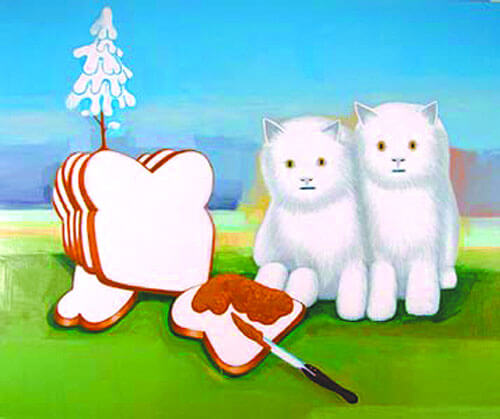David Humphrey may well be inventing the next category to toy with
Reading Kim Levin’s “Farewell to Modernism,” originally published in October 1979 in Arts Magazine, recalls a jubilant and hopeful attitude about possibilities in art. It is a proclamation inviting the impure, politically conscious and synthetic world of art production that Levin freely names Post-Modernism. Reprinted in Richard Hertz’s “Theories of Contemporary Art,” Levin’s piece is illustrated with an image of Judy Pfaff’s 1983 “3-D,” an installation at Holly Solomon Gallery. In this context, Levin’s observation of an art that “scavenges, ransacks, and recycles,” comes alive.
More than 20 years later, it is difficult to even utter that particular “ism,” even though we stand firmly upon its ground. And while many artists work to consolidate strategies from Post-Modernism, purifying processes, like installation, into well-defined forms, others continue to juggle the terms of the impure beyond recognizable expectations.
David Humphrey’s current exhibition at Brent Sikkema Gallery is a stellar example of one artist fruitfully toying with the boundaries of traditional forms. He does so not by merging them into predictable notions of installation or quotation. Rather, Humphrey inhabits the center of many locations with discrete forms, and then mixes things up by extending and reiterating imagery beyond physical and metaphorical limits.
Humphrey is a frighteningly odd storyteller. His narrative impulse swings throughout the painting, sculpture, and installation, carrying us through poignant and goofy territory. His palette, while not exactly saccharin, is more literally the hues of an “artificial sweetener,” shuffling us in and out of sentimentality like a barker at a side show. Once in the tent, one is slightly alarmed by the number of kitties, clowns and poodles.
“Moveable Wave Hutch” thrusts two clans of poodles into a drama of collapsed equatorial divide: the dark ones nestled under a towering tsunami, the white ones exposed against massive tundra. But then these kitsch cousins seem tamer than seemingly more normative vignettes. In “Horsey Love,” a pony spies its lover through a clearing in a snow-blanketed forest. The object of its affection, an upright vacuum, swells its flowery bellows in reply.
With the addition of each concocted story, one becomes increasingly aware of Humphrey’s physical investment in delivering the tale. Vintage store tchtockes are set against the hand-painted and hand-made. Carved marble is beheaded with a found pillow. Paint is applied to objects, stretched canvas, cut wood forms, and the wall, separately and in unison, to achieve an array of pictures that range from sign to illusion. The thrill is this: that this artist continues to play rigorously, inventing messed up locations, which we might otherwise recognize as tidy, by butting the neat encapsulated edge of one form against the seam of another.
We also publish:
Advertising



































